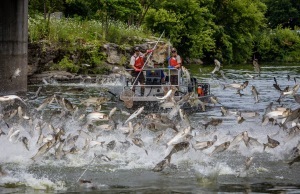|
March 23, 2018
Contact: Joanne Foreman, 517-284-5814
Great Lakes Invasive Carp Challenge finalists
to compete Tuesday in livestream event
 Four Great
Lakes Invasive Carp Challenge finalists – a software consultant, a robotics
professor, a civil engineer and a hydraulic engineer – will compete for
$500,000 in cash prizes during the “Carp Tank” livestream event Tuesday, March
27, beginning at 9:30 a.m. (Eastern) at www.michigan.gov/snyderlive.
Finalists
each will have 15 minutes to explain their proposed methods for keeping
invasive carp from entering the Great Lakes and five minutes to respond to
questions from a four-judge panel. The awards presentation is anticipated at
11:45 a.m. (Eastern) and also will be livestreamed.
In
February 2017, Gov. Rick Snyder announced the Great Lakes Invasive Carp
Challenge, a worldwide search for ideas to stop invasive carp from entering the
Great Lakes.
|
 “Protecting the Great Lakes is a top priority for the
state and its residents because invasive carp pose a serious threat to our
ecology and economy,” Snyder said. “The Carp Challenge has spurred innovators
and entrepreneurs to bring their best ideas to the table to help the Great
Lakes region combat this imminent threat. I’m excited to learn more about their
proposals.”
InnoCentive,
a global crowdsourcing company, posted the challenge from Aug. 1 to Oct. 31,
2017, through its online challenge center, www.innocentive.com, netting 353 entries from 27
countries.
All solutions were
submitted anonymously. Entrants’ names and credentials were withheld until finalist
and runner-up solutions were selected. A panel of expert judges selected four
finalists, who each received $10,000 and the opportunity to compete in
Tuesday’s Carp Tank for prizes of $200,000, $125,000, $100,000 and $75,000.
|
The
four finalists are:
- Edem
Tsikata, a software consultant from Boston who holds a Ph.D. in experimental
atomic physics from Harvard University and spent time as a researcher in NASA’s
Jet Propulsion Laboratory.
- Dr.
D.J. Lee, a Ph.D. in electrical engineering from Texas Tech University who is a
professor and director of the Robotic Vision Laboratory in the Electrical and
Computer Engineering Department at Brigham Young University.
- David
A. Hamilton, a senior policy director for The Nature Conservancy, focusing on
reducing the introduction and spread of aquatic invasive species in the Great
Lakes region. He holds an M.S. in Civil Engineering from the Massachusetts
Institute of Technology.
- Michael
Scurlock, a hydraulic engineer with RiverRestoration who has published multiple
design methodologies for implementation of river restoration structures. He
holds a doctorate from Colorado State University and is a registered
professional engineer.
Judges
also selected six runners-up whose entries they felt were worthy of sharing
with researchers in the field of invasive carp management. Each runner-up was awarded
$25,000 and invited to present their ideas to researchers and venture
capitalists at the Great Lakes Invasive Carp Summit, taking place Tuesday, March
27, following the Carp Tank event.
The
runners-up include:
- Micheal
Ahimbisibwe, the founder and director of research for Bravespec Systems, Ltd.,
an energy and research development company.
- Dr.
Stephen Walker, the chief engineer for Phyre Technologies, developing novel
techniques for liquid and gas deoxygenation.
- Philip
Doberenz, the founder and chief inventor of X-Tirp Inc., which designs and
sells tools to control invasive species.
- Thomas
Bliznik, a resident of Petoskey, Michigan, who works in the power and
industrial market.
- Lawrence
P. Kearns, a founding principal of Wheeler Kearns Architects in Chicago, who
focuses on cultural and education projects with ambitious social, economic and
environmental goals.
- Matthew
Cook, the founder, CEO and technical director of SeaView Systems, Inc., a
global company that uses underwater robotic technology for tunnel inspections
and infrastructure intervention.
Invasive bighead, silver and black carp can significantly
alter the Great Lakes ecosystem, affecting the $7 billion fishery, $16 billion
boating industry and others dependent on the Great Lakes and its tributaries.
In June 2017, a silver carp was caught just nine miles
away from Lake Michigan, below the electric barrier system designed to keep
invasive carp out of the Great Lakes. In
2010, a bighead carp was also captured below the barrier system.
These incidents emphasize the need for action and
innovation to prevent these fish from doing potentially irreparable ecological
and economic damage to Michigan’s signature and defining natural resource.
In January 2018, Governor Snyder announced the formation
of the Great Lakes Basin Partnership to Block Asian Carp. This growing coalition of states and
provinces is committed to supporting the $8 million annual cost of operations
and maintenance for the Army Corps of Engineers’ Tentatively Selected Plan to
reduce the risk of invasive carp from entering the Great Lakes at the Brandon
Road Lock & Dam in Joliet, Illinois.
/Note to editors:
Accompanying photos are available below for download. Suggested caption information
follows.
Carp tank logo: Watch
the Great Lakes Invasive Carp Challenge’s four finalists compete for $500,000
in cash on Tuesday beginning at 9:30 a.m. Eastern at www.michigan.gov/snyderlive.
Jumping Silver Carp: Boaters can and have been injured when
hit by leaping invasive silver carp weighing up to 40 pounds. Photo courtesy Asian Carp Regional
Coordinating Committee.
Invasive carp photos and
video are available via the www.asiancarp.us website, in the Newsroom's
multimedia section./
|